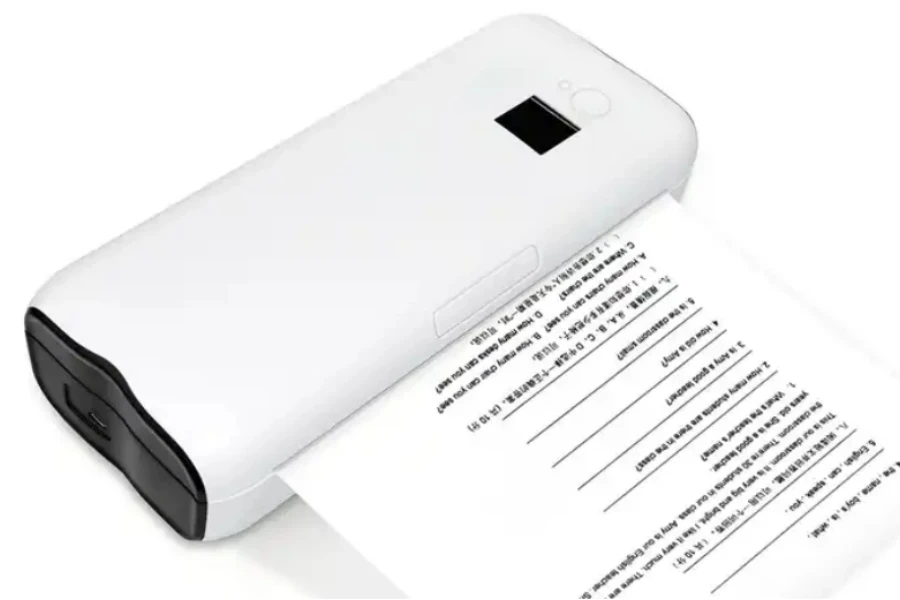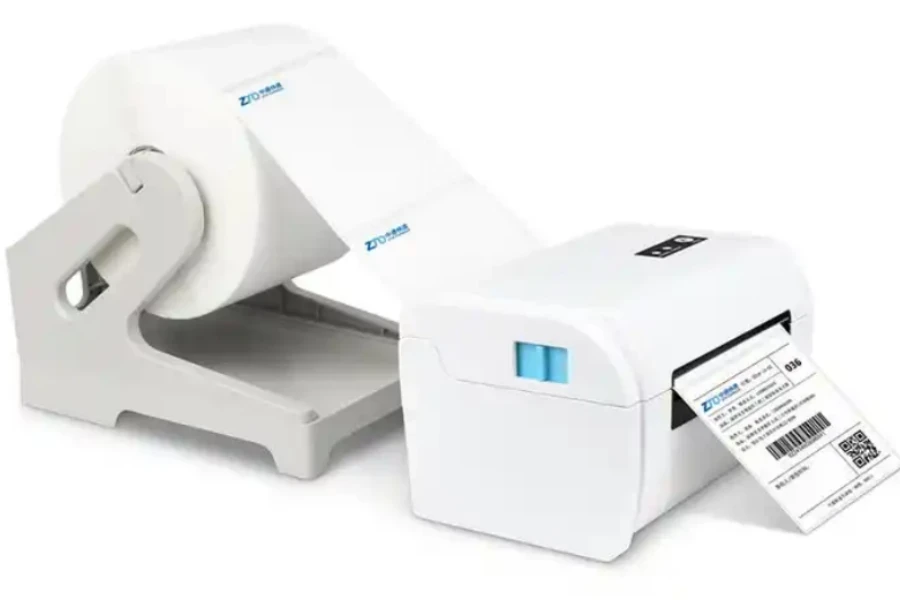In the dynamic sphere of e-commerce, thermal printers have become an indispensable asset for their swift and reliable production of labels and receipts, essential for the seamless operation of fulfillment processes. These robust devices offer a significant advantage by utilizing heat to produce crisp images on specialized paper, eliminating the need for traditional ink cartridges. As a result, businesses experience a marked reduction in operational costs and an increase in workflow efficiency. The strategic selection of a thermal printer can directly influence the logistical success of a company, making it a critical decision for those tasked with procurement.
Table of Contents
1. Thermal printing technology: a 2024 perspective
2. Criteria for selecting superior thermal printers
3. Leading thermal printer models of 2024
4. Conclusion
Thermal printing technology: a 2024 perspective

Advancements in thermal printing
As 2024 unfolds, thermal printing technology continues to evolve, becoming more integral to industries that rely on efficient, high-volume printing solutions. The latest advancements in this field have led to significant improvements in print quality, with manufacturers introducing printers capable of higher resolution outputs. This enhancement is crucial for producing sharper text and more precise barcodes, which are vital for inventory and shipping accuracy.
Market dynamics and adoption rates
The market dynamics of thermal printing are also shifting. A robust growth trajectory is observed, fueled by the technology’s adoption in sectors beyond traditional retail and shipping. Healthcare, manufacturing, and hospitality are increasingly leveraging thermal printers for their reliability and the cost-effectiveness of consumables. The market’s expansion is further propelled by the demand for mobile thermal printers, which offer flexibility in various operational settings.
The global thermal printing market is currently valued at approximately USD 13.3 billion as of 2023 and is projected to reach around USD 28.4 billion by 2033, growing at a compound annual growth rate (CAGR) of 7.8%. The adoption rates of thermal printers are climbing, as businesses recognize the long-term savings in maintenance and supply costs compared to traditional inkjet or laser printers. The absence of ink or toner in thermal printing not only reduces running costs but also aligns with environmental sustainability efforts by minimizing waste. This aspect is becoming a significant factor in procurement decisions, as companies seek to enhance their green credentials.
In summary, the landscape of thermal printing in 2024 is characterized by technological innovation, expanding market presence, and a strong inclination towards sustainable and cost-effective printing solutions.
Criteria for selecting superior thermal printers

Selecting the right thermal printer is a critical decision for businesses that rely on accurate, efficient, and reliable label printing. The market in 2024 offers a variety of advanced options, each with its own set of features designed to meet specific operational needs. Here’s a more detailed look at the key criteria for selecting superior thermal printers.
Print quality and resolution
The cornerstone of an effective thermal printer is its print quality and resolution. High-resolution printers, offering 600 DPI or more, are no longer a luxury but a necessity for businesses that require precision in barcode readability and label clarity. This high resolution ensures that even the smallest text is sharp and that barcodes scan correctly the first time, every time. This is particularly important in industries where accuracy is paramount, such as pharmaceuticals, where a misread barcode can have serious implications.
Compatibility and connectivity
In the current landscape, a thermal printer must be versatile in its compatibility with various operating systems. Printers now come with embedded software that can automatically detect and align with the operating system of the host device, be it Windows, macOS, Linux, or even Android and iOS. Connectivity options have expanded beyond traditional USB and serial ports to include Wi-Fi 6 for faster data transfer, Bluetooth 5.0 for better range and connectivity, and NFC for tap-to-connect capabilities. This ensures that printers can integrate smoothly into any IT infrastructure, making them a versatile tool for businesses of all sizes.
Speed and efficiency metrics

Speed is a critical efficiency metric, with some of the top thermal printers on the market capable of printing at speeds of up to 14 inches per second. This allows businesses to produce large volumes of labels quickly, which is essential for high-throughput environments such as shipping and manufacturing. However, speed must not compromise quality. The best printers maintain high-resolution output even at peak speeds, ensuring that every label is of the highest quality.
Durability and maintenance
Volume handling is another aspect where modern thermal printers excel. They are designed to accommodate large rolls of labels and have high-capacity ribbons, reducing the frequency of replacements. This is complemented by large internal memories that allow for the storage of a vast number of label designs and templates, streamlining the printing process and reducing the time taken to switch between different label types.
Energy efficiency and sustainability
Energy efficiency is becoming increasingly important, and thermal printers are keeping pace. New models are more energy-efficient, reducing operational costs and supporting businesses’ sustainability goals. Some printers also offer sleep modes and other energy-saving features that minimize power usage when the printer is not actively printing.
In conclusion, the selection of a thermal printer in 2024 is a complex decision that involves balancing print quality, compatibility, speed, durability, volume handling, and energy efficiency. Businesses must consider their specific needs and how these features will impact their operations to ensure they choose a printer that offers the best value and performance.
Leading thermal printer models of 2024

The search for detailed features of the top thermal printers in 2024 has led to a variety of sources, including a video guide that outlines some of the best thermal label printers for the year. Here’s a synthesis of the information gathered, tailored to the needs of businesses seeking to invest in the latest thermal printing technology.
High-resolution innovators
The latest high-resolution thermal printers are setting new standards in print clarity. For instance, models like the Markdomain Thermal Label Printer are being lauded for their superior print quality, offering resolutions that can exceed 600 DPI. This allows for the printing of incredibly detailed labels and barcodes, which is indispensable for industries where precision is critical. These printers are not just about the aesthetics of print but about the functional reliability they bring to supply chain management.
Compact and mobile solutions
Mobility has become a significant factor in printer selection, with models like the Niimbot Thermal Label Printer gaining popularity for their compact size and portability. These printers are engineered to fit in small workspaces or to be taken on the road, ideal for businesses that require on-site printing capabilities. They come with battery options that support extensive use, ensuring that printing tasks can be carried out without interruption, regardless of location.
Cost-effective workhorses
Cost efficiency remains a priority for businesses, and thermal printers like the Phomemo Thermal Label Printer are recognized for delivering robust performance at a competitive price point. These printers are designed to be durable workhorses that can handle high-volume printing tasks without frequent maintenance, offering a lower total cost of ownership and a high return on investment.
Color printing capabilities

Color thermal printers are carving out a niche in the market, with models like the Yoaingo Thermal Label Printer providing the ability to print in color. This feature is particularly useful for businesses that need to print color-coded labels for quick identification or wish to include branding elements on their labels and receipts. While color printing in thermal printers is still a developing feature, it represents a significant advancement in the technology, offering new avenues for business branding and product differentiation.
The leading thermal printer models of 2024 are characterized by their high-resolution printing capabilities, compact and mobile designs, cost-effective performance, and emerging color printing functionalities. These features are shaping the choices of businesses looking to enhance their operational efficiency and adapt to the evolving demands of the market. With such advancements, thermal printers continue to be an indispensable tool for a wide range of business applications.
Conclusion
Selecting the optimal thermal printer is a strategic decision that can significantly influence the success of e-commerce fulfillment operations. The advancements in 2024’s thermal printing technology, from high-resolution capabilities to mobile and color printing options, offer businesses a spectrum of choices to enhance efficiency and branding. The right printer can streamline workflows, ensure accuracy in tracking, and provide lasting value, proving to be a pivotal asset in the fast-paced e-commerce arena.




